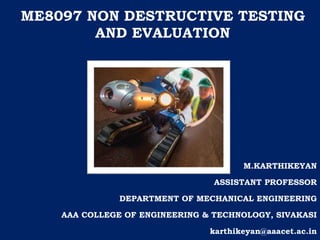
L1 ndt versus mechanical testing &; overview of liquid penetrant test
- 1. OML751 TESTING OF MATERIALS ME8097 NON DESTRUCTIVE TESTING AND EVALUATION M.KARTHIKEYAN ASSISTANT PROFESSOR DEPARTMENT OF MECHANICAL ENGINEERING AAA COLLEGE OF ENGINEERING & TECHNOLOGY, SIVAKASI karthikeyan@aaacet.ac.in
- 2. UNIT I OVERVIEW OF NDT 1. NDT Versus Mechanical testing & Overview of Liquid penetrant test 2. Overview of Magnetic particle test 3. Overview of Thermography test 4. Overview of Eddy current test 5. Overview of Ultrasonic test 6. Overview of Acoustic emission test 7. Overview of Radiographic test 8. Various physical characteristics of materials and their applications in NDT., 9. Visual inspection – Unaided and aided.
- 4. DESTRUCTIVE TEST NON DESTRUCTIVE TEST 1 Used for finding out the properties of the material Used for finding out defects of materials 2 Load is applied on the material Load is not applied on the material 3 Due to load application, material gets damaged No load applications, so no chance for material damage 4 Tested material cannot be reused. Tested material can be reused. 5 Tests are mostly quantitative measurements. Tests are mostly qualitative and rarely quantitative measurements. 6 All measurements are direct Most of the measurements are
- 5. DESTRUCTIVE TEST NON DESTRUCTIVE TEST 7 In – service inspection is not possible In – service inspection is possible 8 Specimen preparation is necessary. Little or no specimen preparation is required. 9 Can measure only one property at a time. Can measure many parameters. 10 Time conception for inspection is more. Rapid inspection is possible 11 Skilled man power is not required to interpret the results Skilled man power is required to interpret the results
- 6. OVERVIEW OF LIQUID PENETRANT TEST
- 7. LIQUID PENETRANT TESTING INTRODUCTION: Used to detect the surface discontinuities in non porous solids. Can be used for both ferrous and non-ferrous materials. Used to detect casting, forging and welding surface defects such as hairline cracks, surface porosity, leaks in new products and fatigue cracks.
- 8. INSPECTION PROCEDURE: Pre-cleaning Application of penetrant Excess penetrant removal Application of developer Inspection Post cleaning
- 12. ADVANTAGES High sensitivity Small discontinuities can be detected Metallic, non-metallic, magnetic, non-magnetic, conductive and non-conductive materials may be inspected. Rapid Inspection of large areas Suitable for complex shapes Indications are produced directly on the surface Indications can reveal relative size, shape, and depth of the flaw Portable Low cost It is easy and requires minimal amount of training
- 13. DISADVANTAGES Only surface and near surface defects can be detected Only non-porous surface can be inspected Pre-cleaning is critical Post cleaning is required Chemical handling and proper disposal is required. Surface finish and roughness can affect inspection sensitivity. Fumes can be hazardous and flammable without proper ventilation
- 14. PART - A 1. Distinguish between destructive testing and non destructive testing(UN, CO1) PART - B 1. Explain the sequence of operations of liquid penetrant testing 2. Compare the destructive testing methods and non-destructive testing methods with respect to its advantages and limitations QUESTIONS